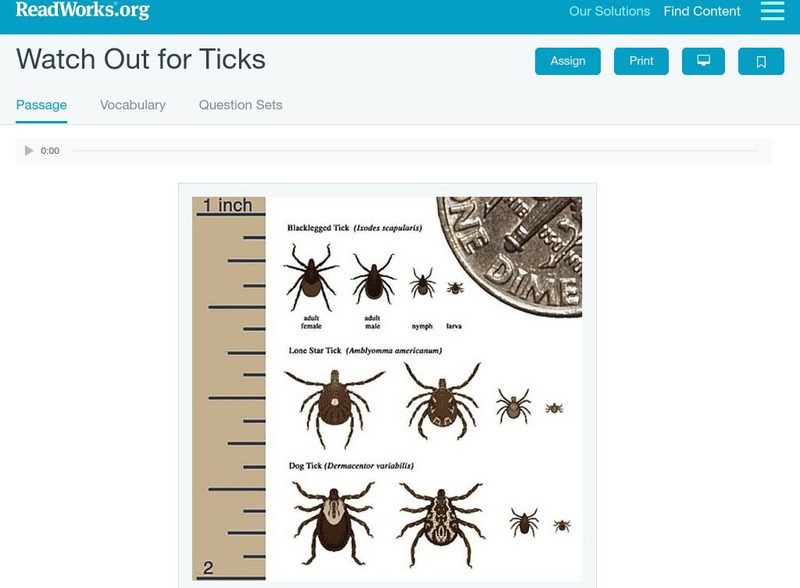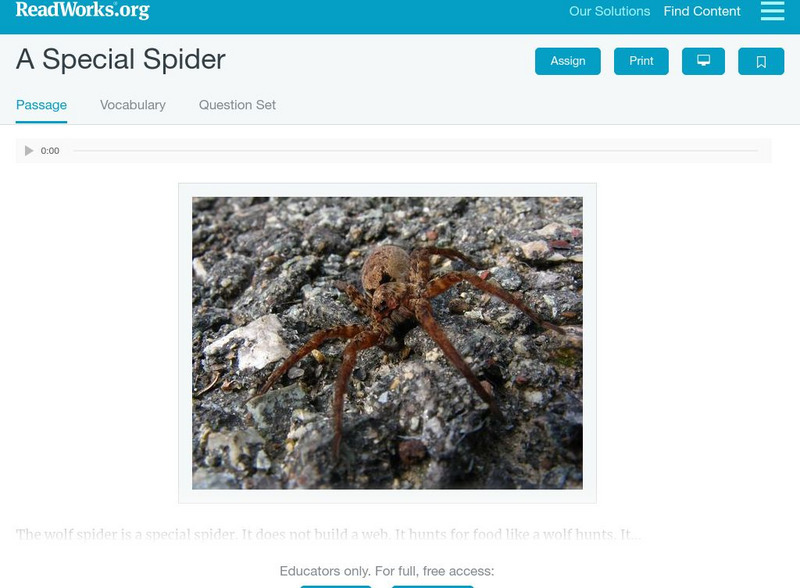Soft Schools
Soft Schools: Spiders All Over
Take this interactive, multiple-choice quiz over different types of spiders, then review your score and any missed questions at the end.
Other
Harry's Big Adventure: Lesson Plans: Spider and Insect Detectives
Lesson plans that include group activities and handouts to introduce students to the differences between spiders and insects.
Akron Children's Hospital
Akron Children's Hospital: Kidshealth: Hey! A Black Widow Spider Bit Me!
Read this article to learn about the black widow spider, one of six poisonous kinds of spiders in the United States.
Akron Children's Hospital
Akron Children's Hospital: Kidshealth: Hey! A Brown Recluse Spider Bit Me!
The brown recluse spider is one of six poisonous kinds of spiders in the United States. Read this article for kids to learn more about this venomous spider.
Akron Children's Hospital
Akron Children's Hospital: Kidshealth: Hey! A Scorpion Stung Me!
Scorpions are about three inches long with eight legs and a small pair of claws that look like crabs' claws. Read all about them in this article.
Akron Children's Hospital
Akron Children's Hospital: Kidshealth: Hey! A Tarantula Bit Me!
A tarantula is a black, hairy spider that is about two to three inches long. Learn all about spiders and tarantulas in this article for kids.
Akron Children's Hospital
Akron Children's Hospital: Kidshealth: Hey! A Chigger Bit Me!
If you get bit by a chigger, the bite will be very itchy! Learn more about these tiny mites in this article for kids.
University of Kentucky
University of Kentucky: European Red Mite
A resource with information on the red mite including management in relation to farming.
Burke Museum
Burke Museum: Spider Identification
As part of the Arachnology section of the Burke Museum, this site corrects false conceptions associated with identifying spiders.
PBS
Pbs Teachers: Scientific American: Calls of the Wild: Spider Sounds
Explore the communication rituals of insects and other arachnids by constructing a device capable of detecting minuscule impacts of cricket feet.
Regents of the University of Michigan
Animal Diversity Web: Phylum Arthropoda
This general overview of the arthropod phylum, which includes insects and arachnids, looks at such topics as body symmetry, appendages, movement, respiratory and nervous systems, and reproduction.
Ducksters
Ducksters: Animals for Kids: Tarantula
Investigate the arachnid Tarantula which is a large harry eight-legged poisonous spider.
Ducksters
Ducksters: Animals for Kids: Scorpions
All information about scorpions can be found on this website. These arachnids have eight legs, pincers, and a stinger on their tail that can poison.
HotChalk
Hot Chalk: Lesson Plans Page: Spooky Spiders
This simple lesson plan is designed to introduce young young scholars to the characteristics of a spider and to classify whether a spider is an insect or an arachnid by analyzing its characteristics.
Library of Congress
Loc: Everyday Mysteries: Spiders and Their Webs
Have you ever wondered how spiders avoid getting stuck in their own webs? Check out this excellent explanation.
Wikimedia
Wikipedia: Arthropod
Wikipedia offers information on arthropods, the largest phylum of animals. Includes scientific classification chart and image.
University of Kentucky
University of Kentucky: Common Spiders
Find concise information that chronicles common spiders found around homes and buildings. Several descriptions and pictures are included on this site.
University of Kentucky
University of Kentucky: Brown Recluse Spider
Webpage reference on the brown recluse spider which is more poisonous than a black widow and is more often found infesting homes and businesses.
American Museum of Natural History
American Museum of Natural History: Pseudoscorpions O Logy Card
Flip this interactive OLogy card to find fast facts, questions and answers, and other bite-size pieces of information about pseudoscorpions.
American Museum of Natural History
American Museum of Natural History: White Tailed Spider O Logy Card
Turn over this interactive card and start learning bite-size pieces of useful information about the white-tailed spider, such as their diet and physical characteristics.
Read Works
Read Works: Calling All Spiders!
[Free Registration/Login Required] An informational text about different types of spiders found in North America. A question sheet is available to help students build skills in reading comprehension.
Read Works
Read Works: Watch Out for Ticks
[Free Registration/Login Required] This passage shares nonfiction information about ticks. This passage is a stand-alone curricular piece that reinforces essential reading skills and strategies and establishes scaffolding for vocabulary...
Read Works
Read Works: A Special Spider
[Free Registration/Login Required] An informational text about the wolf spider. A question sheet is available to help students build skills in reading comprehension.
BiologyWise
Biology Wise: A Detailed Description of the Anatomy of Spiders
Describes anatomical features of a spider, including its external structure, eyes, mouth parts, digestive system, circulatory system, respiratory system, nervous system, reproductive system, and its spinnerets.
Other popular searches
- Arachnids Characteristics
- Arachnids and Insects
- Arachnids Information Report
- Arachnids/ Spiders
- Arachnids and Spiders
- Arachnids Spiders
- Arachnids and Webs
- Arachnids Life Cycles
- Arachnid Lesson
- Arachnids Red Back
- Arachnida
- Arachnids Charateristics





















